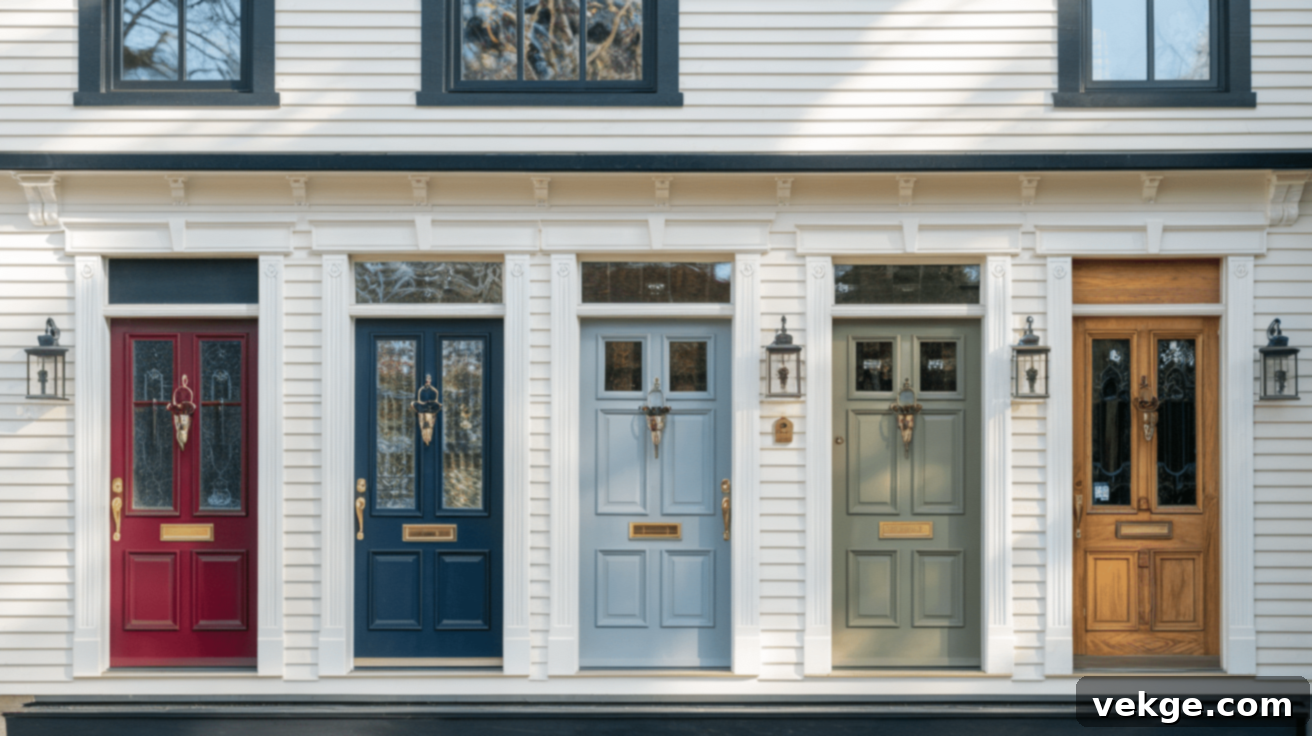Elevate Your Home’s Style: Choosing the Perfect Front Door Color for White Houses with Black Trim
Have you ever encountered a home that seemed to exude personality and charm, almost as if it were greeting you with a warm smile? Often, this captivating first impression is set by the front door. For a classic white house with striking black trim, the front door isn’t just an entry point; it’s a focal point, an opportunity to infuse your home with character and make a memorable statement.
Imagine a vibrant red door that radiates cheerfulness and welcome, or a tranquil navy blue that subtly invites peace and calm. The color you choose for your front door speaks volumes about your home’s character and your personal style, even before guests step inside. It’s the very first element visitors notice, effectively setting the tone for the entire interior.
This comprehensive guide is designed to help you navigate the exciting world of front door colors, ensuring you find the perfect shade that resonates with your aesthetic, enhances your home’s curb appeal, and brings a smile to your face every time you approach your entrance.
Strategic Front Door Colors for White Houses with Black Trim
Selecting the ideal front door color goes far beyond simple aesthetics. It’s a thoughtful decision that involves considering how the chosen hue integrates with your home’s existing architectural style, harmonizes with the surrounding neighborhood, and stands up to local climate conditions. The right color has the power to transform your white house, creating a balanced, polished, and inviting look.
A well-chosen front door color can significantly boost your home’s curb appeal and perceived value. It should reflect your individual taste while enhancing your property’s unique characteristics. For white houses with black trim, the strong, clean contrast offers a fantastic canvas, allowing almost any door color to truly pop and become a standout feature.
Architectural Style: Guiding Your Color Choice
Different home styles inherently lend themselves to particular color palettes. Before you commit to a color, take a moment to truly appreciate your home’s architectural lineage and design elements. Matching your door color to your home’s style ensures a cohesive and historically appropriate look.
- Georgian and Federal-style homes, known for their symmetry and formality, often benefit from sophisticated black or deep, rich red doors that echo their grand and traditional nature.
- Colonial homes typically shine with classic, timeless colors such as navy blue, forest green, or even a muted cranberry, which complement their historical roots.
- Modern or Contemporary houses, with their clean lines and minimalist aesthetic, can daringly embrace bolder, more vibrant choices like bright yellow, teal, or even a sleek high-gloss black to emphasize their innovative design.
- Craftsman homes, celebrated for their natural materials and artisanal details, pair beautifully with earthy tones like forest green, warm browns, or even a deep, muted orange that complements stone and wood accents.
- Ranch-style homes offer remarkable flexibility. Their unpretentious design allows for a wide range of colors, from subtle grays to cheerful yellows, providing ample opportunity for personal expression.
- Victorian houses, with their intricate trim work and ornate details, are perfectly suited for richer, more complex colors like deep plum, emerald green, or a sophisticated teal, which highlight their intricate craftsmanship.
- Mid-century modern homes often feature clean lines and a connection to nature. They look exceptional with bright, clear colors such as sunny yellow, vibrant orange, or deep turquoise, which provide a striking contrast against their simple forms.
Observing similar homes in your area or within your architectural style can offer invaluable inspiration, helping you select a color that feels authentic and harmonious with your property’s design.
Balancing Personal Preference with Neighborhood Trends
While your front door should undoubtedly be a reflection of your unique personality, it’s also wise to consider the prevailing aesthetics of your neighborhood. A short stroll around your block can reveal what colors seem to work well on similar homes, offering helpful context without dictating your choice.
Your personal preference remains paramount, as you’ll be interacting with your front door every single day. However, being mindful of local trends and unwritten community standards can help your home feel connected to its surroundings while still showcasing your individual flair.
Some neighborhoods, particularly planned communities or historic districts, might even have specific guidelines or homeowner association (HOA) rules regarding acceptable exterior color palettes, including front doors. Always check these before making a final decision to avoid costly repaints.
If you’re contemplating selling your home in the near future, more universally appealing neutral door colors (like black, charcoal, or navy) tend to attract a broader range of buyers. That said, a thoughtfully chosen, vibrant color can also make your home more memorable to potential buyers during a competitive house hunt.
Climate Considerations: Protecting Your Investment
The local climate plays a significant role in the longevity and appearance of your front door paint. Environmental factors can dictate how quickly a color fades or how well the paint adheres over time.
In regions with intense, prolonged sunlight, darker or more vibrant colors may fade much faster, requiring more frequent repainting. Conversely, in wet or humid climates, certain paints may be more prone to mildew, bubbling, or peeling, necessitating specific formulations or regular maintenance.
Coastal homes, for instance, face the unique challenges of salt spray and high humidity, which can accelerate paint degradation. For these environments, high-quality, marine-grade paints with excellent adhesion and mildew resistance are often the best choice.
For houses in hot, sunny climates, dark colors absorb more heat, which can lead to premature fading and even warp certain door materials. Lighter colors reflect heat, keeping your door cooler, but they may show dirt and grime more easily, especially in rainy areas. Cold northern climates, prone to freeze-thaw cycles, require highly flexible paints that can expand and contract without cracking or chipping.
Even the direction your door faces matters: south and west-facing doors receive the most direct sun exposure, making UV-resistant paints crucial. Many reputable paint brands now offer climate-adapted formulas specifically designed to perform optimally in various regional conditions. Consult with local paint professionals for tailored advice on the best products for your area.
Top Front Door Colors for a White House with Black Trim
The inherent contrast of a white house with black trim provides an elegant, clean slate, allowing your front door color to truly shine. Whether you opt for a bold, dramatic hue or a softer, more subtle shade, the right choice can perfectly highlight your home’s architectural features, add a touch of warmth, or infuse it with personality. The key is to select a color that perfectly embodies the mood and message you wish your home to convey.
1. Classic Red
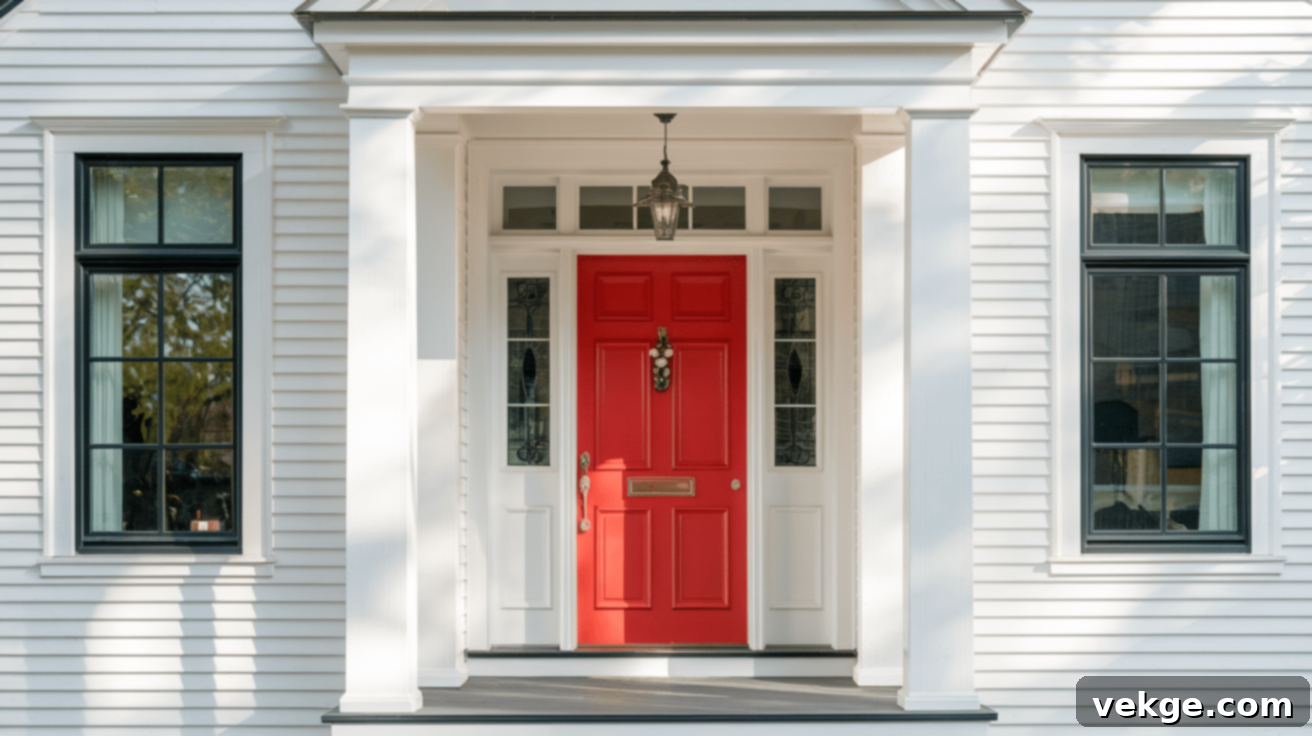
A red front door instantly injects warmth, energy, and a welcoming spirit into a white house. It’s an unmistakably friendly color that makes your entrance easily identifiable and unforgettable. The strong contrast red provides against crisp white walls and black trim creates a dynamic focal point, drawing the eye directly to your entryway.
Historically, a red door carries rich symbolism; in American tradition, it often signifies “welcome,” while in Feng Shui, it attracts good energy. The inherent boldness of red performs well in all seasons, appearing festive in winter and lively in summer. It can also visually anchor a smaller home, making it feel more substantial and inviting.
Ideal Styles: Colonial, traditional, craftsman, farmhouse, and even modern homes seeking a classic pop of color.
Finish Options: A semi-gloss finish offers a pleasant sheen that reflects light without highlighting every minor imperfection. For a truly dramatic and bold statement, a full gloss finish creates a mirror-like surface, though it demands meticulous surface preparation and shows flaws more readily.
Maintenance Tips: Keep it clean with a gentle soap and water solution. Promptly touch up any chips or scratches to prevent moisture infiltration and premature peeling, especially in high-traffic areas.
2. Navy Blue
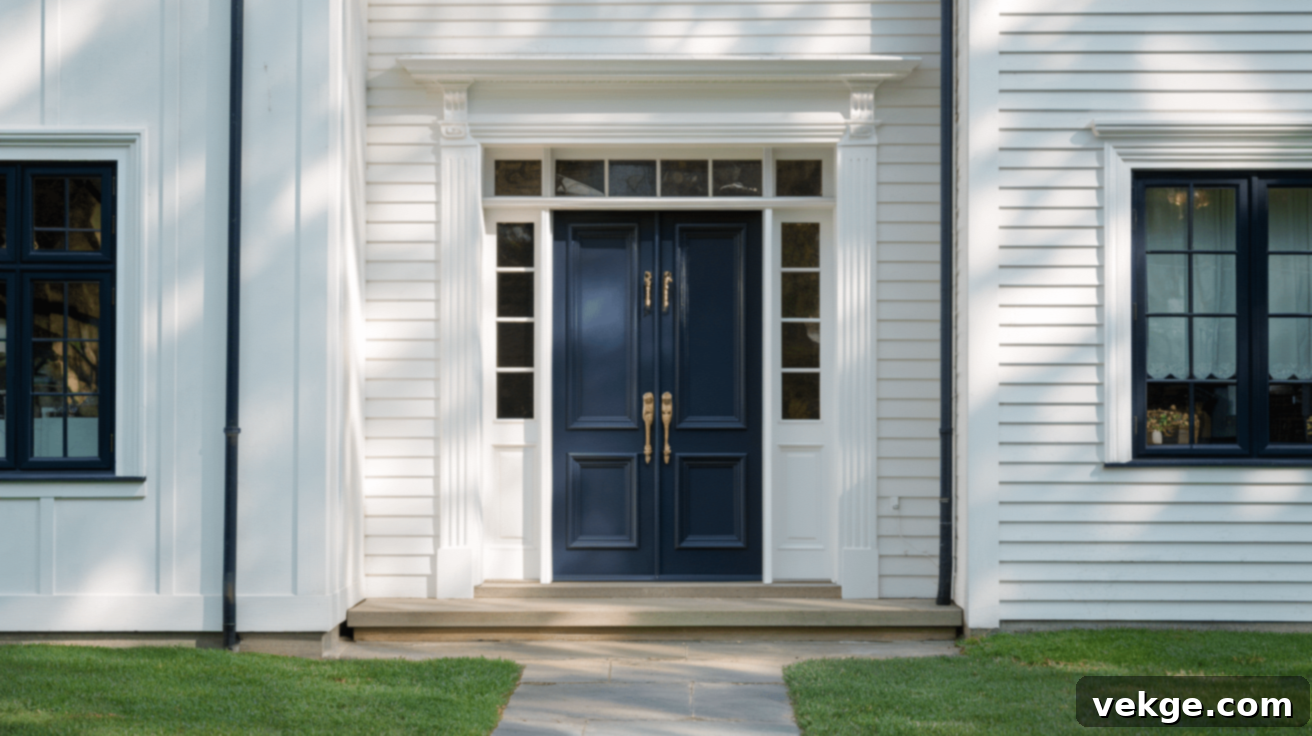
Navy blue conveys a profound sense of calm, stability, and quiet confidence. It’s a sophisticated and formal choice without feeling overly stuffy. This deep, rich color has timeless appeal, often associated with maritime heritage, and pairs exquisitely with polished brass or brushed nickel hardware for a truly classic and refined aesthetic.
A navy door creates a stately and enduring entrance that feels both traditional and refreshingly current. This versatile hue performs beautifully in varying light conditions and is quite forgiving when it comes to showing minor dirt or smudges. It can also lend a sense of importance and depth to smaller entryways, making them feel more grounded and significant. Navy is an excellent choice for homes with patriotic accents or a refined, coastal-inspired design.
Ideal Styles: Cape Cod, colonial, coastal, traditional, and transitional homes.
Finish Options: A satin finish strikes the perfect balance between too shiny and too flat, subtly masking minor surface imperfections while maintaining a fresh, sophisticated appearance.
Maintenance Tips: Inspect for fading every few years, particularly if your door faces direct sunlight for extended periods. A UV-resistant topcoat can help prolong its richness.
3. Forest Green
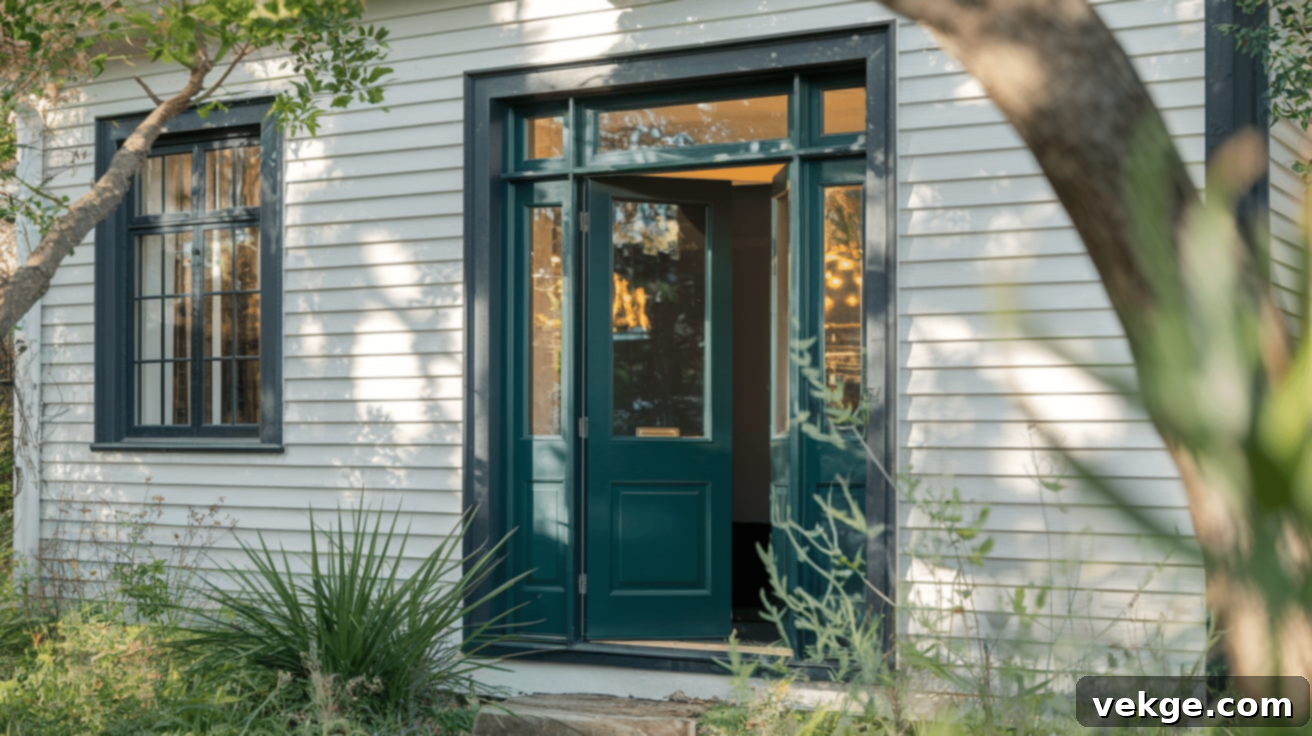
Forest green beautifully connects your home to its natural surroundings, fostering a peaceful and harmonious atmosphere. This deep, verdant shade evokes the calming tranquility of dense woodlands, bringing a touch of nature’s serenity to your entrance. It’s particularly well-suited for homes nestled among abundant landscaping, mature trees, or those with gardens, creating a seamless visual transition from the yard to the home’s exterior.
Less common than red or blue, a forest green door lends your home a distinct and refined character. The color subtly transforms throughout the day, appearing almost black in deep shadow and revealing its rich green hues in full sunlight. It harmonizes wonderfully with natural stone accents, raw wood elements, and brickwork.
Ideal Styles: Tudor, craftsman, country, traditional, and homes with a strong connection to nature.
Finish Options: Matte finishes can enhance green’s natural, organic feel, while glossier options can add a captivating depth and richness to the color.
Maintenance Tips: Wash annually or bi-annually with a gentle cleaner to prevent dirt, pollen, and mildew buildup, especially in any textured areas of the door.
4. Bright Yellow
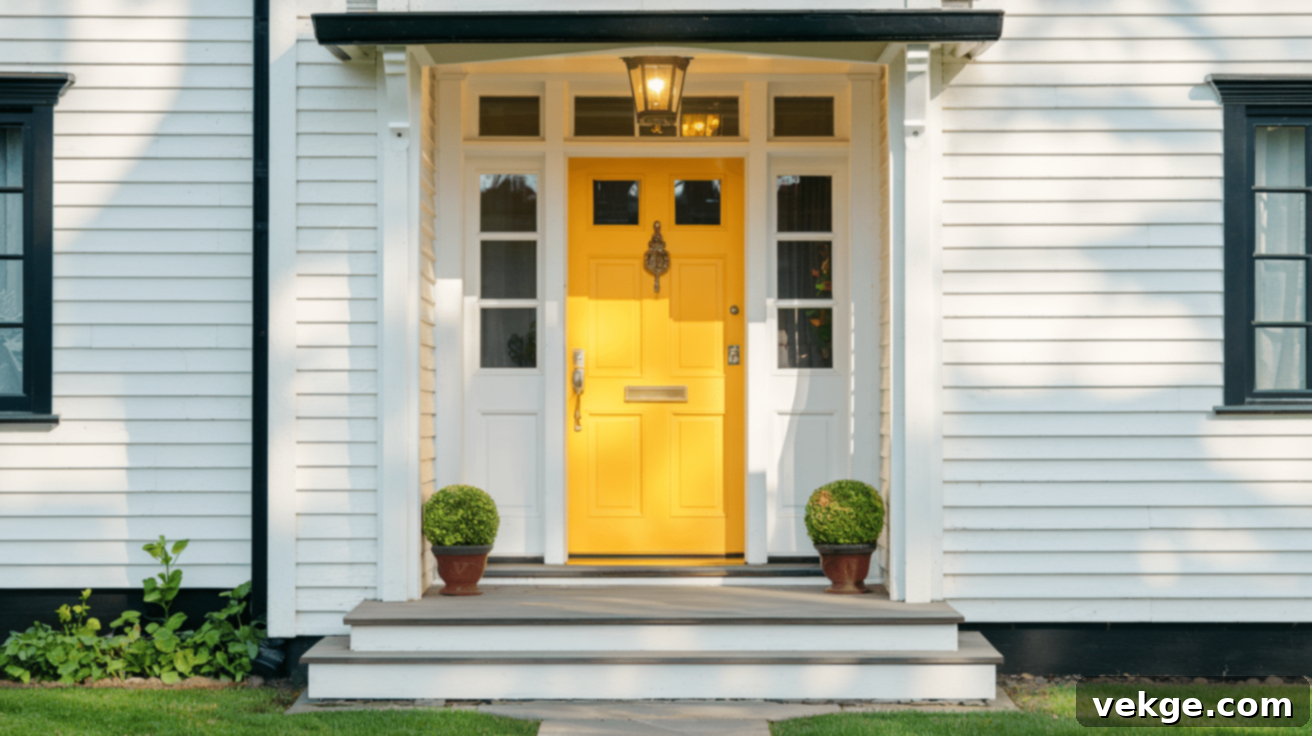
A bright yellow front door instantly radiates sunshine, cheerfulness, and an undeniable sense of happiness to your entrance. It’s an overtly friendly and approachable color that immediately lifts spirits. This vibrant hue creates a delightful contrast against white walls and black trim, offering an instant mood boost for anyone arriving at your home.
Yellow doors capture morning light beautifully, appearing to glow with warmth, and continue to radiate a soft luminescence in the late afternoon sun. Symbolically, yellow is often associated with optimism, creativity, and good energy. It pairs exceptionally well with charcoal gray or matte black hardware for a modern, sophisticated edge, or with bronze for a more rustic feel.
Ideal Styles: Cottage, modern, Mediterranean, and homes in sunny climates or those wanting to project a joyful personality.
Finish Options: A semi-gloss finish helps yellow maintain its brightness and makes it easier to clean, reflecting light without being overly reflective.
Maintenance Tips: Yellow tends to show dirt and environmental smudges more readily than darker colors, so regular cleaning is essential. Be prepared for potential repainting sooner than darker hues, as yellows can sometimes fade more quickly in intense sunlight.
5. Black
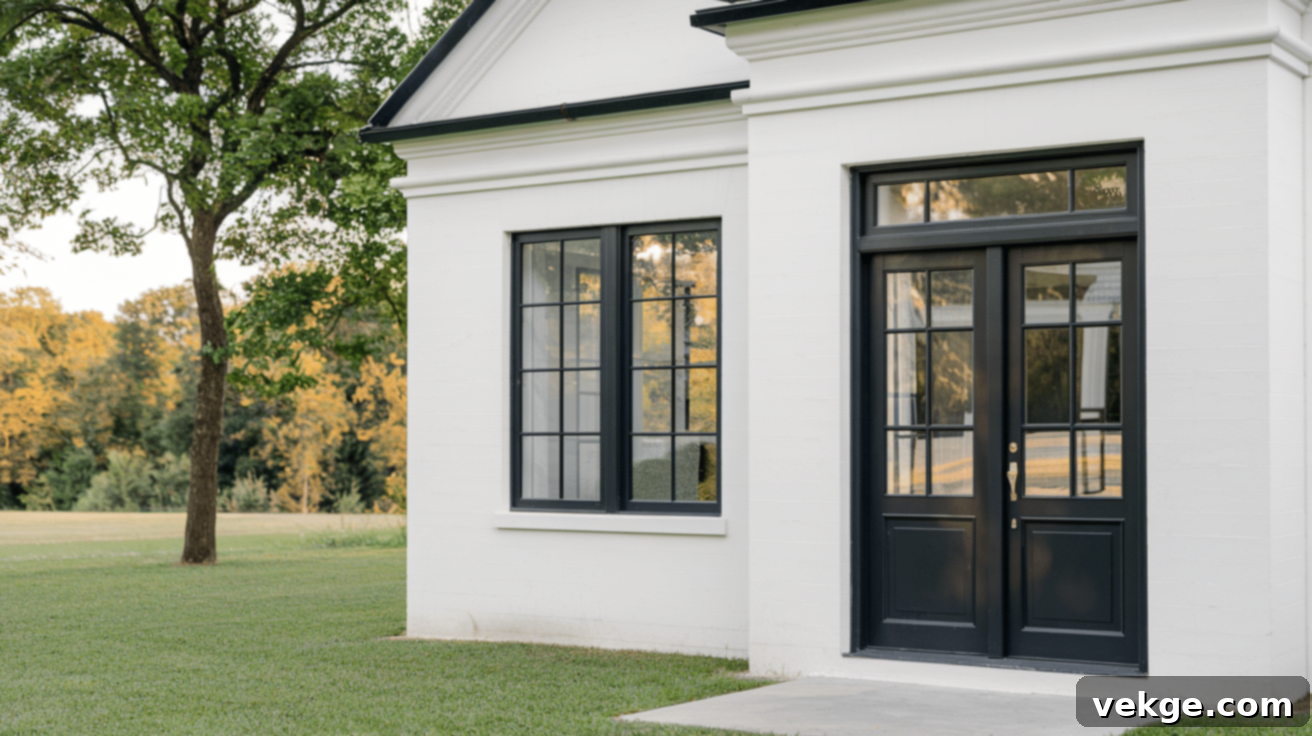
Black front doors are the epitome of classic sophistication and timeless elegance. They create a sharp, dramatic contrast with white walls and seamlessly integrate with black trim, offering a sleek and refined aesthetic. This enduring choice has remained popular for centuries across virtually every architectural style, from quaint cottages to grand estates.
A black door makes an assertive yet understated statement, exuding an air of formality and gravitas. It pairs effortlessly with any hardware finish, from the gleaming warmth of polished brass to the contemporary coolness of brushed nickel or oil-rubbed bronze. Black doors can also absorb heat in colder climates, which can be a subtle benefit in winter, and they undeniably create a strong focal point that draws the eye directly to your home’s entrance. Black looks impeccable in all seasons and is excellent at concealing minor dents, dings, or dirt better than lighter colors, adding a sense of weight and importance to your home’s entry.
Ideal Styles: Works flawlessly with almost any architectural style, from traditional and colonial to ultra-modern and minimalist.
Finish Options: A high-gloss black finish creates a strikingly modern, mirror-like surface that reflects light beautifully. For a softer, more subtle effect, a satin or matte black can offer a sophisticated, velvety appearance.
Maintenance Tips: While black hides minor blemishes, dust and fingerprints are quite visible, so regular wiping with a soft cloth is recommended to maintain its pristine look.
6. Turquoise
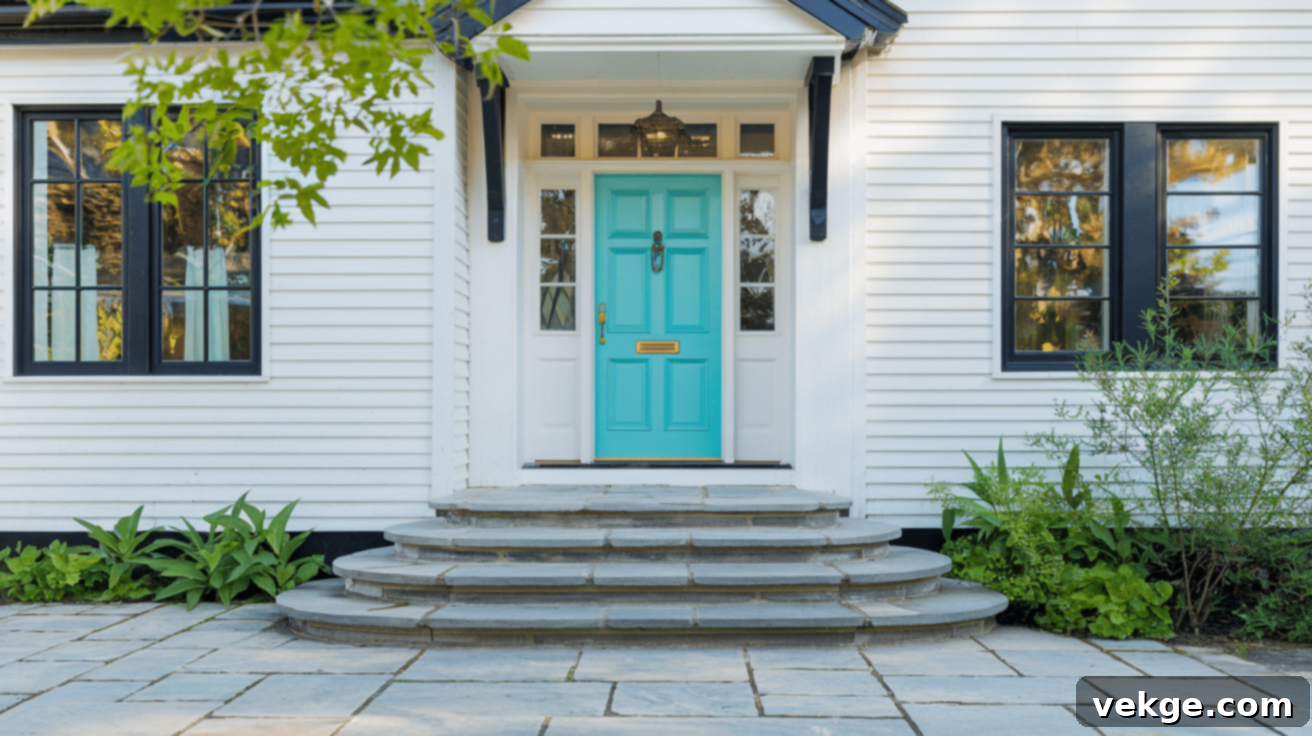
Turquoise is a refreshing and distinctive color that adds a touch of unique personality without being overly flamboyant. This captivating blue-green shade conjures images of tropical waters and clear, inviting skies. It strikes a perfect balance between cheerful and sophisticated, making it suitable for family homes seeking a burst of character.
A turquoise door creates a cool, inviting entrance, particularly in hotter climates, and can inject a welcome splash of warmth and color into northern homes during colder months. It stands out beautifully in photographs and makes your home effortlessly identifiable for first-time visitors. This color works especially well with natural stone pathways, drought-tolerant landscaping like succulents, and complements coastal or desert-inspired aesthetics. Turquoise also holds cultural significance in many Southwestern traditions as a color of protection and healing.
Ideal Styles: Beach houses, Southwestern, mid-century modern, bohemian, and eclectic homes.
Finish Options: A satin or semi-gloss finish will help maintain the color’s inherent vibrancy and make it easier to clean, allowing its lively hue to truly pop.
Maintenance Tips: Turquoise may be susceptible to fading in strong, direct sunlight. Consider installing an awning or portico for added protection to help preserve its brilliant color over time.
7. Charcoal Gray
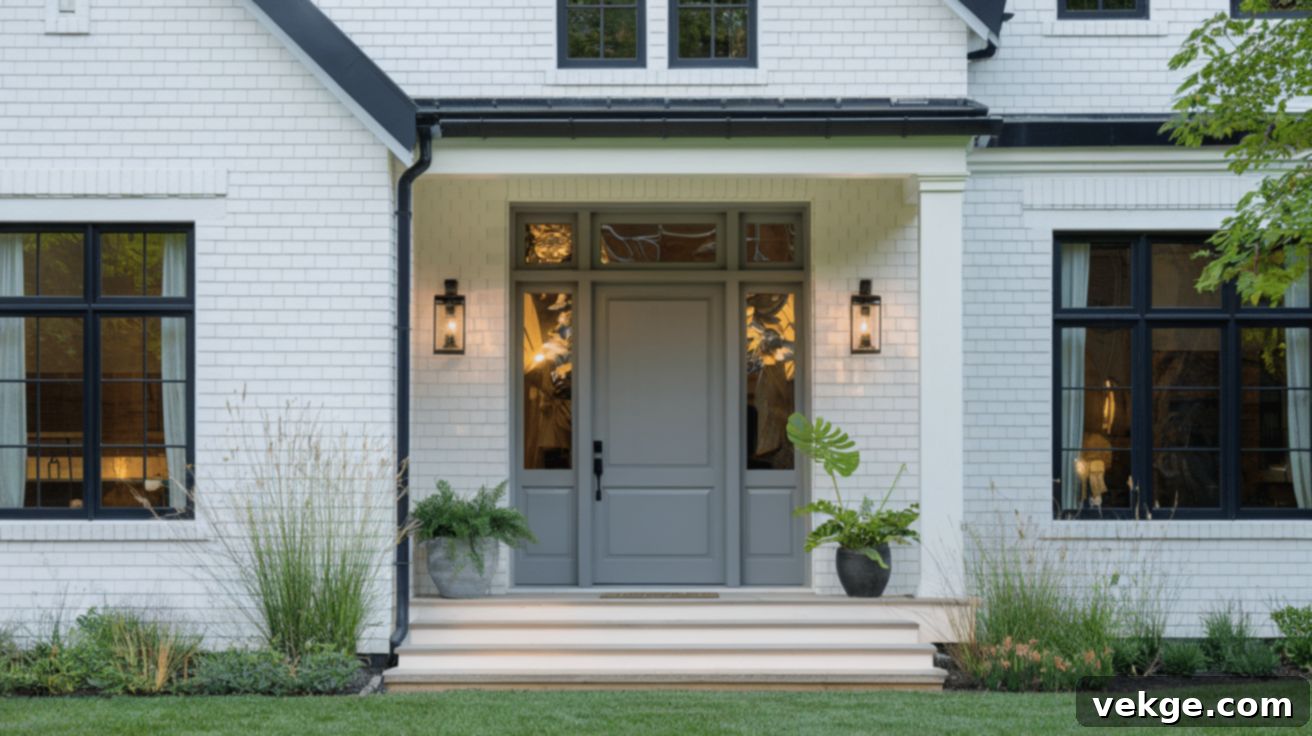
Charcoal gray offers a sleek, modern, and understated elegance. It serves as an excellent middle ground if true black feels too intense or stark for your taste. This deep, versatile gray possesses a nuanced depth that shifts with the light, sometimes appearing almost black, other times revealing subtle blue or warm brown undertones.
This highly adaptable color pairs seamlessly with any hardware finish, from contemporary stainless steel to classic bronze, and complements both warm and cool color schemes within your landscaping. Charcoal gray projects a sense of being current and sophisticated without overtly trying too hard, making it a stylish yet practical choice. It also excels at hiding dirt and minor imperfections, making it ideal for busy households with frequent door usage. This hue feels equally at home in bustling urban environments and serene rural settings, offering universal appeal.
Ideal Styles: Contemporary, transitional, minimalist, industrial, and traditional homes seeking a modern twist.
Finish Options: Matte to satin finishes work exceptionally well with charcoal gray, imparting a smooth, refined, and undeniably current look that emphasizes its sophisticated depth.
Maintenance Tips: This color is remarkably easy to maintain, requiring only occasional cleaning with mild soap and water to keep it looking fresh.
8. Deep Purple
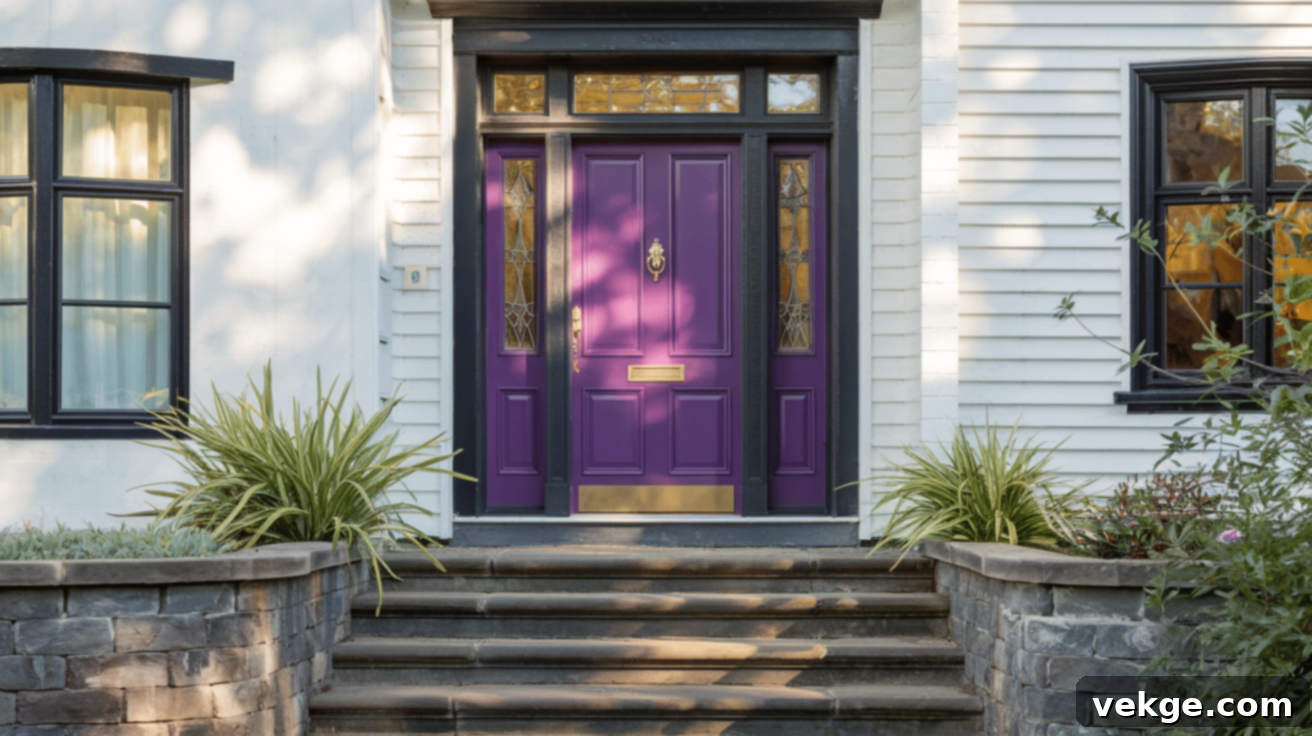
Deep purple adds an opulent richness and distinctive character to your home’s exterior. It’s an unconventional yet sophisticated choice that is different without being overtly bold. This regal shade carries historical connotations of wealth, creativity, and nobility, making a subtle yet powerful statement.
Against white walls and black trim, a deep purple door creates a wonderful sense of depth and intrigue, subtly hinting at the homeowner’s unique taste and willingness to embrace distinctive style. The color beautifully enhances gold and brass hardware, creating an elegant contrast. Deep purple performs well in various lighting conditions; northern light tends to bring out its cooler, blue undertones, while southern exposure will highlight its warmer, redder notes. It’s a truly captivating blend of classic elegance and tasteful individuality that will make your home stand out in a sophisticated way.
Ideal Styles: Victorian, eclectic, arts and crafts, bohemian, and homes looking for a touch of refined luxury.
Finish Options: A satin or semi-gloss finish is highly recommended as it helps showcase the rich depth and complexity of the purple hue, preventing it from appearing flat.
Maintenance Tips: This rich color may require more frequent touch-ups to maintain its intensity, especially in areas with high sun exposure. Consider a high-quality, fade-resistant paint.
9. Teal
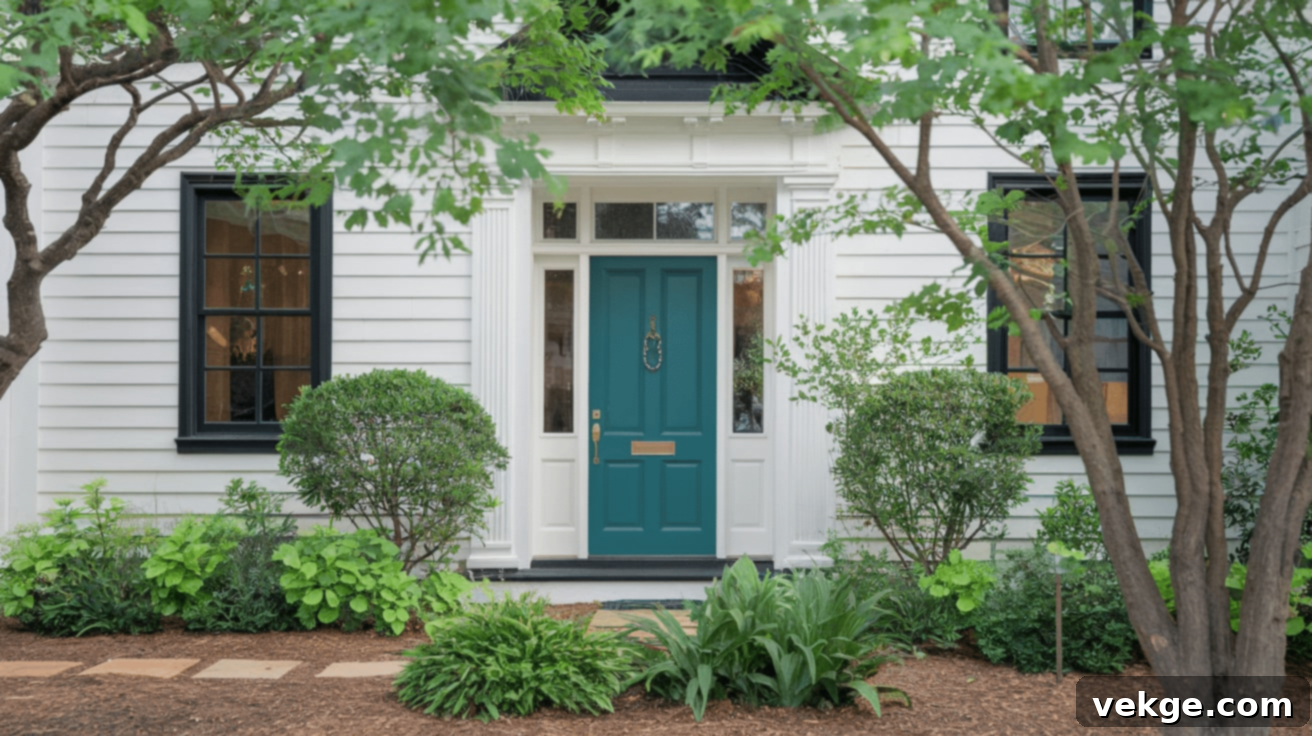
Teal beautifully blends the serene calm of blue with the refreshing, natural feel of green. This vibrant yet soothing color draws inspiration from both the sky and the sea, creating a balanced, peaceful, and inviting entrance. Teal is wonderfully dynamic, shifting in appearance throughout the day – often appearing more blue in the soft morning light and leaning greener towards midday and afternoon.
It’s both eye-catching and incredibly soothing, striking an ideal balance. The color pairs harmoniously with natural materials like wood, stone, and even metallic accents. Teal stands out gracefully against crisp white walls and black trim without being overly loud, making your entrance noticeable but not ostentatious. It’s also an excellent choice for homes featuring copper accents or light fixtures, as the beautiful patina of aged copper perfectly complements teal.
Ideal Styles: Coastal, craftsman, contemporary, modern, and homes seeking a unique, tranquil vibe.
Finish Options: A semi-gloss finish is perfect for teal, helping the color pop and adding a subtle luminosity that accentuates its dual blue-green nature.
Maintenance Tips: Regular cleaning is recommended to prevent dullness. Keep an eye on the color in highly sunny spots, as some teal shades can gradually change over time.
10. Coral
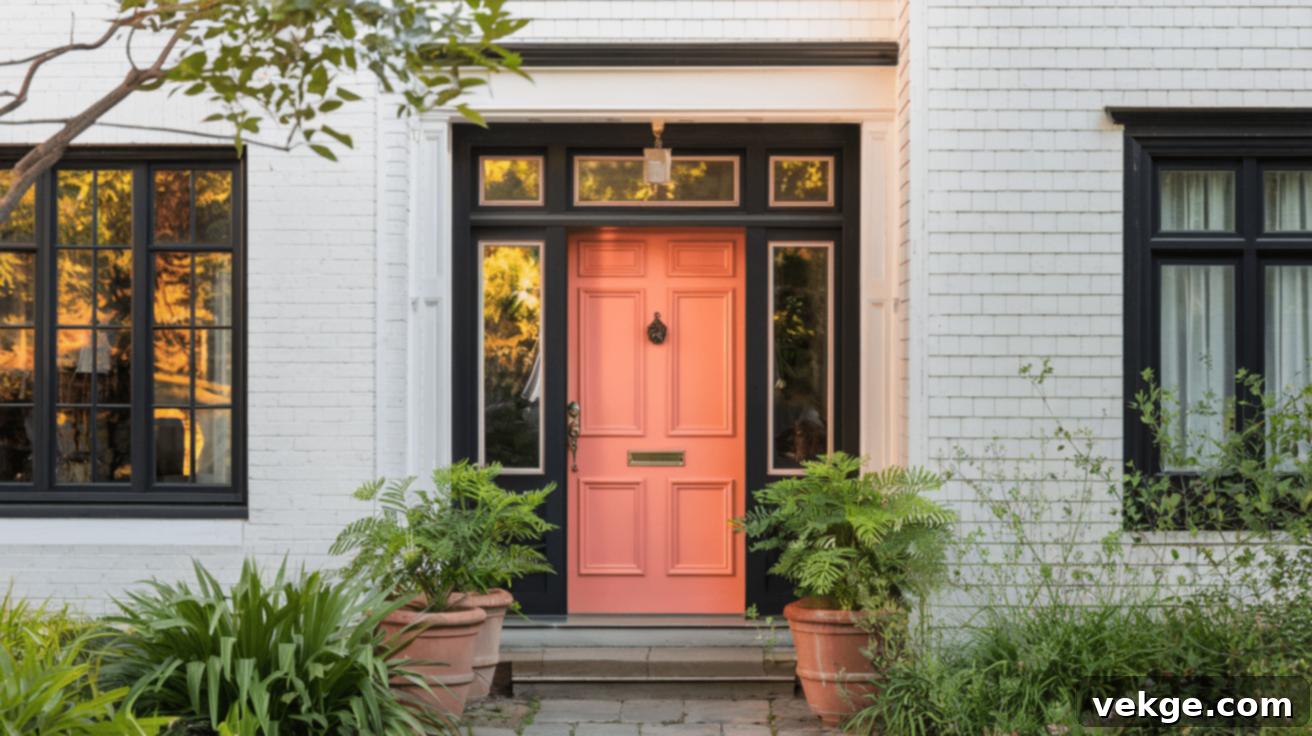
Coral is a friendly, warm, and utterly captivating color that offers a less intense alternative to traditional red. This charming peachy-pink tone brings a unique softness, brightness, and welcoming glow to your entrance. It exudes happiness and approachability while maintaining a sophisticated, adult sensibility suitable for any style of home.
Coral looks absolutely stunning in the golden hour light of late afternoon and is particularly effective at brightening up north-facing entrances that receive limited direct sunlight. The color harmonizes beautifully with homes featuring terra cotta roof tiles, clay planters, or Mediterranean-inspired landscaping. Coral has a relaxed, casual feel that instantly puts visitors at ease. It photographs exceptionally well, making your home look inviting and distinctive in online listings or social media posts.
Ideal Styles: Florida-style homes, beach cottages, Spanish revival, Mediterranean, and homes in warmer climates.
Finish Options: A satin finish helps coral achieve a rich, creamy appearance rather than a stark, candy-like hue, giving it a more refined and organic feel.
Maintenance Tips: Due to its lighter pigment, coral may be prone to fading in strong, prolonged sunlight. Consider repainting every 3-4 years, especially if your door receives heavy sun exposure, or use a high-quality exterior paint with excellent UV protection.
What Your Front Door Color Says About You and Your Home
The color you choose for your front door communicates a powerful, often subconscious message to visitors and passersby. It’s a subtle form of non-verbal communication that can influence how people perceive your home and, by extension, your personality.
- Red doors often symbolize a welcoming spirit, passion, or good luck, depending on the culture. They suggest a homeowner who is bold, confident, and perhaps traditional.
- Blue doors typically hint at calm, stability, and trustworthiness. They convey a sense of peace and a homeowner who is grounded and reliable. Navy blue specifically suggests formality and tradition.
- Yellow doors exude optimism, cheerfulness, and creativity. They imply a homeowner who is friendly, outgoing, and enjoys a lively, positive atmosphere.
- Black doors suggest sophistication, elegance, and control. They project an image of authority, order, and a homeowner who appreciates classic style and timeless appeal.
- Green doors are often associated with nature, growth, and prosperity. They convey a sense of harmony, balance, and a homeowner who values peace and environmental connection.
- Purple doors hint at creativity, luxury, and individuality. They suggest a homeowner who is artistic, imaginative, and unafraid to express a unique, refined taste.
- Gray doors (especially charcoal) convey modernity, stability, and understated elegance. They suggest a homeowner who is sophisticated, composed, and appreciates contemporary design.
- Turquoise or Teal doors speak to individuality, freshness, and a playful spirit. They often suggest a homeowner who is adventurous, enjoys coastal vibes, and has a vibrant personality.
Color psychology experts confirm that these impressions are formed rapidly and can significantly impact how people feel about your home even before they step through the threshold. Studies have even shown that homes with thoughtfully chosen, aesthetically pleasing front door colors can sell faster and sometimes for a higher price than comparable properties with less inspired, standard white or brown doors. Your front door truly is an extension of your home’s soul.
Practical Tips for Picking the Perfect Shade
Finding the ideal front door color involves much more than simply choosing a hue you like. The interplay of light, surrounding elements, and practical considerations are all crucial. A color that appears stunning on a small paint chip in a store can look dramatically different once applied to your actual door, under real-world conditions.
Lighting is a powerful determinant of how colors are perceived. What might seem like the perfect shade at noon could appear too dark and muted at sunset, or too bright and washed out on an overcast day. Taking the time for careful evaluation and testing in your specific environment can save you significant time, money, and potential frustration in the long run.
Test Before Committing: The Golden Rule
This is arguably the most critical step to ensure satisfaction with your final choice. Visualizing a color on a small swatch is vastly different from seeing it on the full scale of your door.
- Acquire Samples: Purchase small sample pots of your top 2-3 color contenders.
- Create Swatches: Paint a generous section (at least 12×12 inches) onto a large piece of sturdy cardboard or foam board, or directly onto a less conspicuous part of your actual door if you’re comfortable.
- Observe Throughout the Day: Place the painted swatch directly on your door and observe it at various times throughout the day. Morning light tends to reveal cooler tones, while afternoon sun brings out warmth and vibrancy. Don’t forget to check it on a cloudy or overcast day, as diffused light can drastically change perception.
- Step Back: View the swatch from the street, from your driveway, and from different angles to gauge its impact from afar.
This small investment of time and money can prevent the significant cost and effort of repainting an entire door. Also, consider fixed elements that surround your door and cannot be changed, such as your roof color, exterior siding (beyond white), stone or brick accents, and even the colors of nearby homes. Taking photos of your home’s exterior at different times of day can help you spot color themes and interactions you might otherwise miss when standing close to the door.
Balance Bold and Subtle: Finding Your Sweet Spot
If you’re drawn to a bright, vibrant color but worry it might be too overwhelming for your home’s exterior, consider opting for a deeper, more muted version of that hue. Colors that have a subtle hint of gray or brown mixed in often appear more sophisticated, grown-up, and timeless, rather than overly trendy or childish.
Many paint manufacturers offer “muted,” “historic,” or “desaturated” versions of popular colors that retain the essence of the basic hue but tone down its intensity. These options often integrate more harmoniously with exterior palettes and stand the test of time better than the most vivid shades displayed on a paint chip. Experiment with these nuanced variations to achieve a personalized yet refined look.
Think About Your Hardware: The Finishing Touch
Your front door’s hardware – including handles, knockers, and hinges – plays a crucial role in the overall aesthetic. The finish of your hardware should complement, rather than clash with, your chosen door color.
- Oil-rubbed bronze or antique brass works beautifully with earthy tones like forest green, deep reds, and rich blues, lending a classic, traditional feel.
- Bright, polished brass creates a striking contrast and luxurious pop against dark, sophisticated colors like black, navy, or deep emerald, but might appear too flashy or dated with certain bright, modern doors.
- Brushed nickel or matte black hardware offers a contemporary, minimalist look that pairs exceptionally well with charcoal gray, sleek black, or crisp white doors.
- Bronze and copper tones can add warmth and character to colors like coral, turquoise, or warm grays.
If purchasing new hardware isn’t within your current budget, consider updating existing hardware. Many hardware pieces can be carefully cleaned, primed, and spray-painted with specialized metal paint for a fresh, updated look. Ensure any painted hardware finishes will withstand local weather conditions and frequent use without chipping or fading prematurely.
Keeping Your Front Door Fresh and Vibrant
Your front door is a hardworking element of your home, constantly exposed to the elements – scorching sun, driving rain, biting snow, and daily wear and tear. A well-maintained door not only keeps your home looking its best but also protects your significant investment in exterior aesthetics. Implementing simple, consistent care routines can dramatically extend the life of your door’s paint finish by many years, saving you money on premature repainting. With just a few minutes of attention each season, your front door can retain its fresh, welcoming appearance as beautifully as the day it was painted.
Establishing a Repainting Schedule
Most front doors, under average conditions, typically require repainting every 5 to 7 years. However, several factors can influence this timeline significantly:
- Sun Exposure: Doors facing south or west, which receive intense, direct sunlight for many hours each day, may need fresh paint as frequently as every 3-4 years due to accelerated UV damage and fading.
- Paint Quality: Investing in high-quality exterior paints specifically formulated with UV protection and fade resistance can extend the repainting interval.
- Climate Harshness: Doors in areas with extreme weather (e.g., coastal salt spray, heavy rain, harsh winters with freeze-thaw cycles) will generally need more frequent attention than those in milder climates.
- Color Choice: Lighter colors tend to show dirt more easily but reflect heat, which can preserve the door’s material. Darker colors hide dirt better but absorb more heat, potentially leading to bubbling or warping in very hot areas.
- Traffic: Doors in high-traffic households might experience more physical wear and tear, necessitating earlier touch-ups or repaints.
Make it a habit to inspect your door annually for any signs of chipping, cracking, fading, or peeling. Catching small issues early can prevent them from escalating into larger, more costly problems.
Cleaning Different Finishes: Tailored Care
The finish of your front door not only impacts its visual appeal but also dictates the most appropriate cleaning methods. Each type of finish requires specific care to maintain its integrity and lustrous appearance for as long as possible. Regular cleaning is crucial; it prevents the buildup of dirt, grime, and environmental pollutants that can degrade paint over time and helps you identify minor issues before they become major concerns. The correct cleaning approach can add years to your door’s lifespan and keep it looking pristine between paint jobs.
- Glossy Finishes: These highly reflective surfaces are best cleaned with a soft microfiber cloth and a gentle solution of mild dish soap and warm water. Avoid abrasive cleaners or harsh scrubbing pads, which can dull the shine or leave visible scratches.
- Matte Finishes: Matte doors have a velvety, non-reflective appearance. Dust them regularly with a soft duster or cloth to prevent accumulation. When cleaning, use a very gentle, diluted soap solution and a soft sponge, dabbing rather than scrubbing, to avoid creating shiny spots or streaks that disrupt the matte effect.
- Satin Finishes: Striking a balance between glossy and matte, satin finishes are quite versatile. Clean them with mild soap and water, using a soft cloth or a soft-bristled brush for any textured areas or intricate detailing where dirt might accumulate.
Quick Fixes and Touch-Ups: Proactive Maintenance
Keeping a small, clearly labeled container of your exact front door paint is a smart preventative measure for quick and easy repairs. Addressing small chips, scratches, or scuffs immediately is vital, as it prevents moisture from penetrating the finish and causing larger areas of peeling or damage later on. Properly stored paint, kept in an airtight container away from direct light and extreme temperatures, will remain usable for touch-ups for a surprisingly long time.
- Storage Tips: Always ensure paint cans are tightly sealed to prevent drying out. Store them upside down (to create an airtight seal) in a cool, dry, dark place, like a utility closet or basement.
- Preparation is Key: Before applying any touch-up paint, meticulously clean the damaged area with mild soap and water, then allow it to dry completely. Gently sand any rough edges around the chip with fine-grit sandpaper (220-grit or higher) for a smooth finish.
- Application Technique: Apply multiple thin layers of paint rather than one thick coat. Thin layers dry more evenly, adhere better, and blend more seamlessly. Always allow each layer to dry thoroughly according to the paint manufacturer’s instructions before adding the next.
- Right Tools for the Job: For tiny chips and scratches, a fine-tipped artist’s brush provides precision. For slightly larger areas, a small foam brush or a clean cotton swab can work well.
- Timeliness: Address damage promptly. Exposure to the elements, particularly rain or humidity, can quickly worsen minor paint chips by allowing water to get underneath the existing paint.
- Frequent Check-Ins: Pay particular attention to high-traffic areas like around the doorknob, kick plate, and the edges of the door, checking them every few months.
- Blending: When applying touch-up paint, feather the edges of the new paint slightly outward to help it blend more naturally with the older, surrounding paint.
- Weather Conditions: Avoid performing touch-ups in very hot, cold, or humid conditions, as extreme temperatures and moisture can negatively affect paint drying and adhesion.
Final Thoughts on Your Home’s Welcoming Statement
The color of your front door, though seemingly a minor detail, wields significant power in shaping your home’s character and your emotional connection to it. It’s the very first element that welcomes you back each day, and its impact on your mood and your home’s overall aesthetic is profound.
Throughout this guide, we’ve explored a diverse palette of colors that beautifully complement a classic white house with black trim, delved into practical application tips, and outlined effective strategies for keeping your door looking pristine for years to come. Remember, there isn’t one universal “right” color; the perfect shade is ultimately the one that resonates most deeply with you, reflects your unique style, and makes your heart sing.
Trust your instincts when a particular color catches your eye and evokes a positive feeling. After all, this is your home – a canvas for your personal expression – and your individual style matters most. We sincerely hope this comprehensive guide empowers you to find that perfect front door color that makes you smile with pride every time you pull into your driveway.
